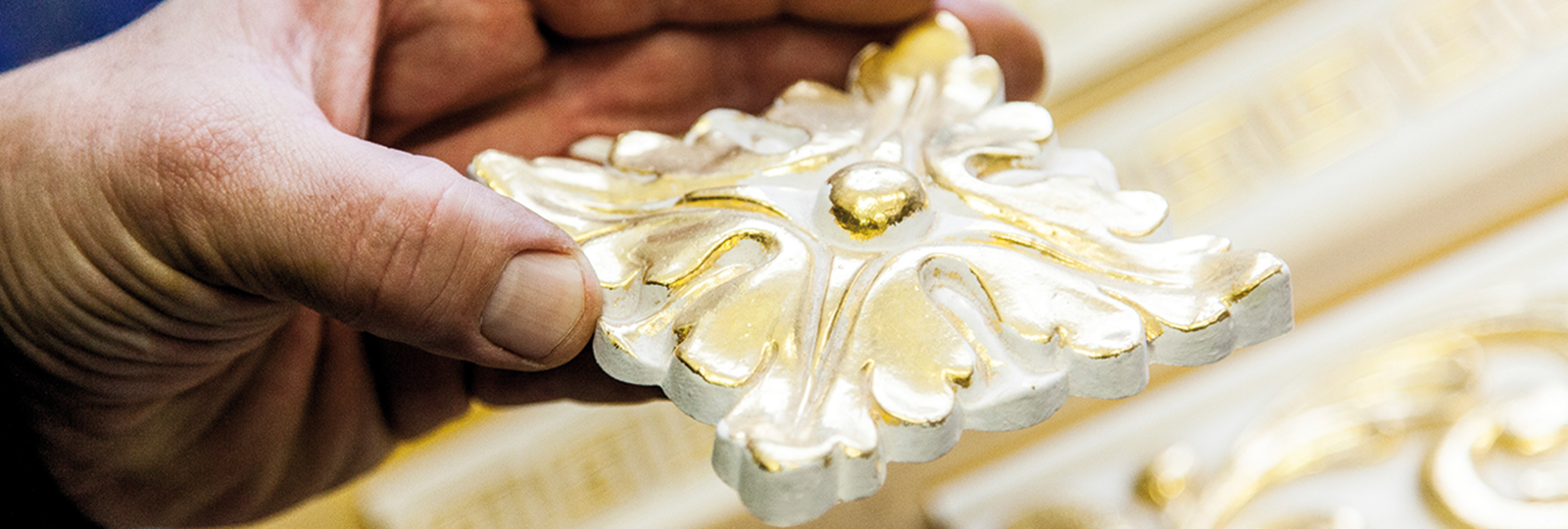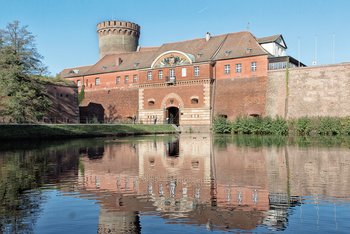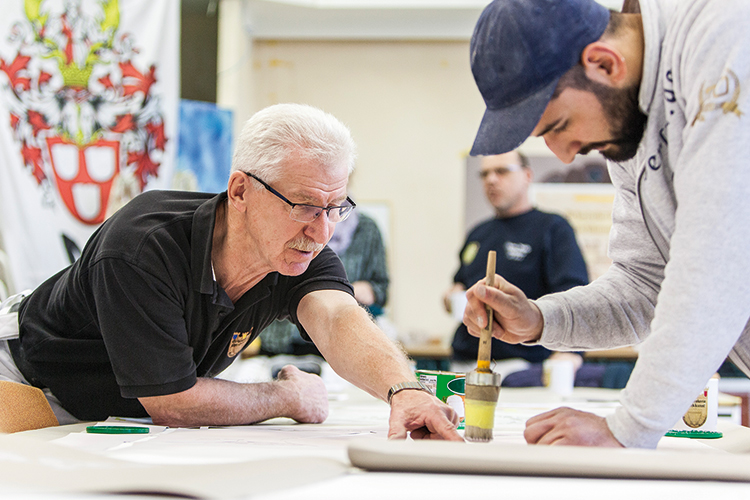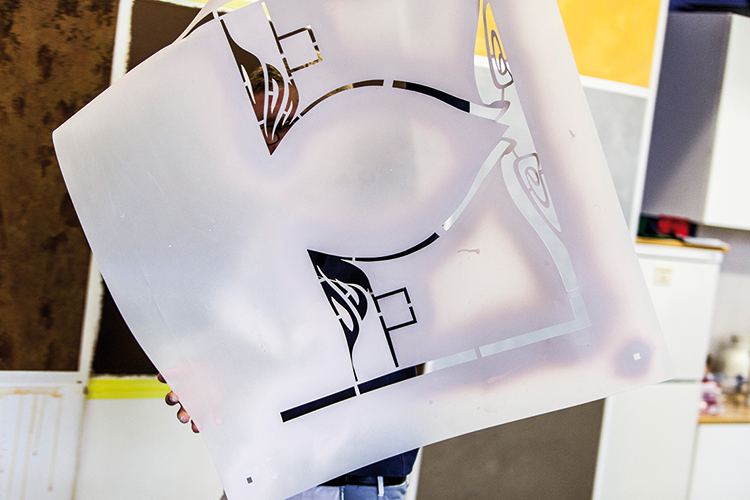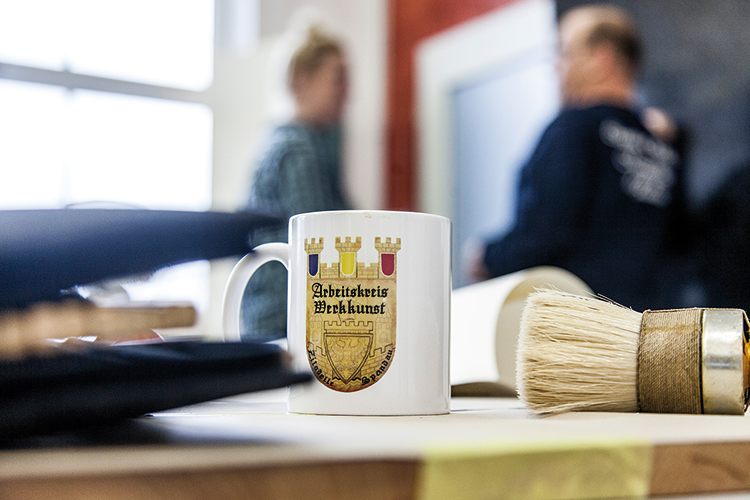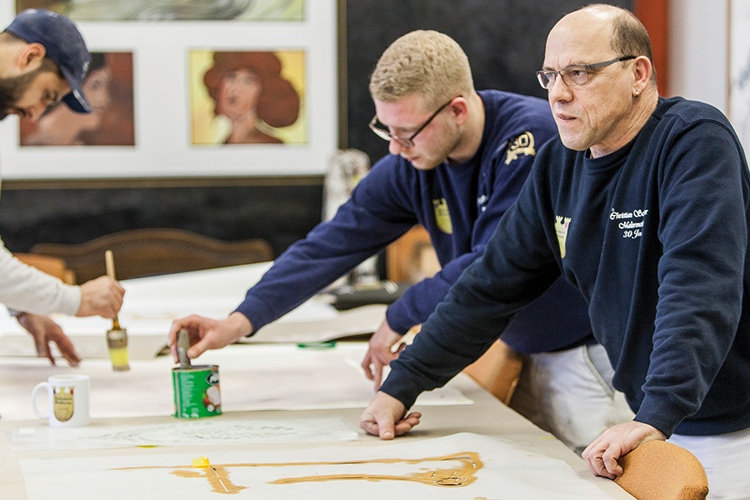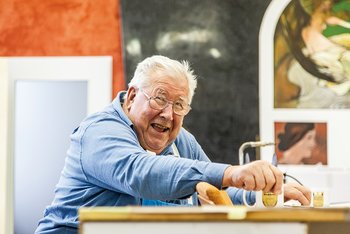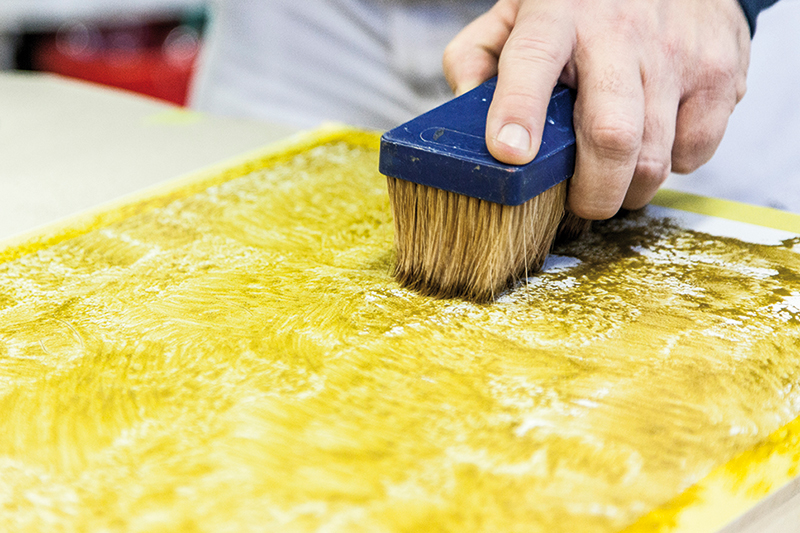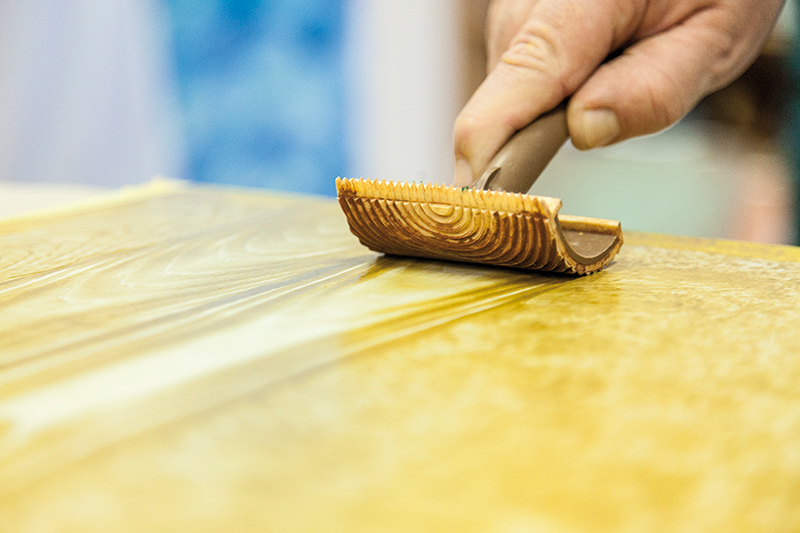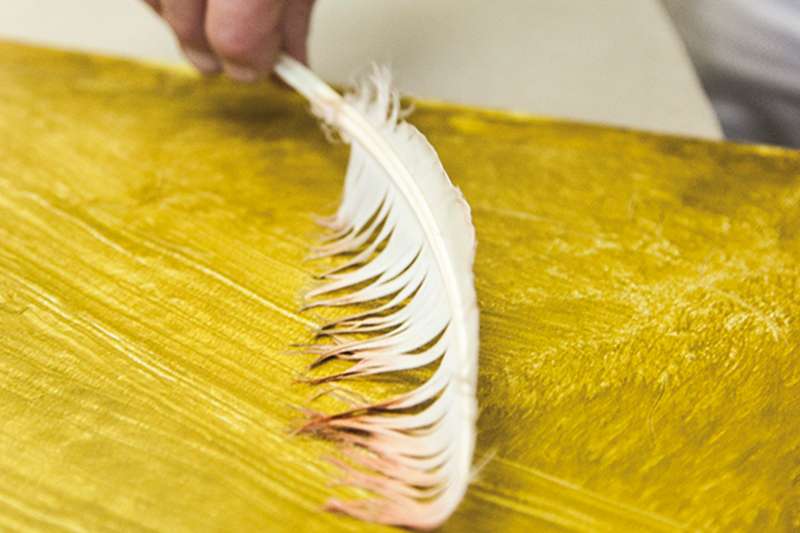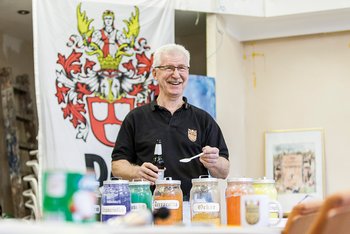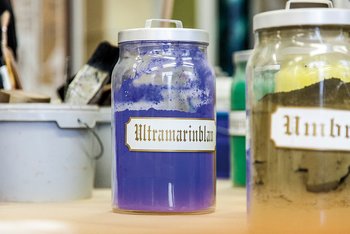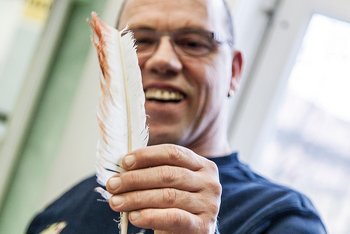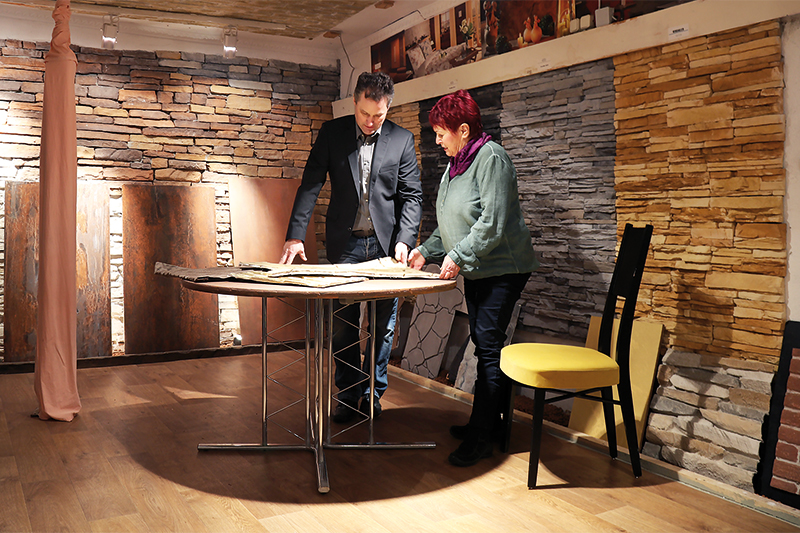The Painters of the Round Table
Photos: Roland Justynowicz, Wikimedia
This article was first published in the MarktImpulse, ed. 1/18
Trained and experienced painters and decorators applied all their strength and skills in creating a marble effect at Spandau Citadel by using templates with great attention to detail. The tools used included feathers, sponges and horsehair brushes.
No coffee, no conversation, no colleague introductions Instead, the visit to the citadel started with a joke. The three apprentices, who were completely focused on tapping a ceiling template with the tips of their brushes moments before, were now shaking with laughter. This wasn’t due to the joke - the boys had heard that one a long time ago - but rather the manner of the person telling it.
Klaus-Peter Engelhardt once again takes a deep breath, causing his white overall stretch significantly and he starts laughing before he has even said a word. "This 76-year-old master painter and decorator is treated like a king here", Christian Schiller explains. He continues saying that the best thing about the community is that they can always laugh about something.
But then the 57-year-old raises his index finger and says "Klaus-Peter is not only a walking joke box, he is also a living encyclopedia of experiences." Master painters and decorators Schiller and Engelhardt have known each other for 39 years. Both are founding members of a professional group dedicated to artwork (Arbeitskreis Werkkunst), based at the Citadel in Berlin-Spandau, Germany, a renaissance fortress dating back to the 16th century.
With their ten master painter and decorator colleagues the group has been working for the past 20 years to preserve outdated methods from past centuries, enliven the quality of painting and decorating and pass on their experiences.
Christian Schiller even thinks that their association is similar to a guild. However, there is one crucial difference: "We enjoy the benefits, such as unconditional camaraderie and the shared expertise, but don't have to suffer archaic disadvantages, such as forced labor and very low prices."
Ox gall, aphids and toxic pigments
You won't find any of that here. The Citadel's master painters and decorators don't consider themselves to be conservators that use original tools and paint materials for restoration where at all possible. "Much the contrary", Christian Schiller says. "We aim for a perfect look, not originality – at a decent price." For this purpose, the twelve members of the group may also use horsehair brushes, beer and gold leaf (see box) in addition to contemporary equipment and pigments to imitate the archaic, elaborate and time-consuming methods more cost-effectively.
Their "playgrounds", as the painters and decorators call them, include old staircases in Berlin, due to be restored to their original condition without spending too much of the budget on materials. "We are experts in the art of imitation and illusion", the 57-year-old says to describe his association's special character. "It doesn't have to be genuine, it just needs to look genuine."
They use stucco made of Styrofoam, factory-made paints and the columns they work on are hollow featuring a marble look. However, they are coated entirely manually, just like the experts' predecessors would have done: They pressed many layers of lime onto each other with a spatula until they created a surface as smooth as a mirror.
The only old thing in their studio ("Except for Klaus-Peter?", one of the trainees says jokingly) is equipment that is more than a century old and has been put on display on shelves and in glass display cabinets: Lime spray guns as large as a dandy horse, scales with space for a small elephant and waist-high drums with rusty fittings lend the facilities an air of past eras.
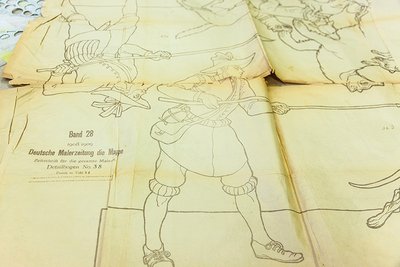
137 years of "Mappe"
The oldest specialist magazine in the German language was published for the first time in 1881. The carefully drawn and folded pages were compulsory reading for painters, varnishers and gilders. The citadel masters found these yellowed issues by chance in the attic of a customer, whose father had once been a calligrapher. Lucky for the painters: One of the templates drawn there dating back to 1900 was used just a few months ago in the stairway of an old building in Berlin: "The people are once again ready to show what they have", explains Christian Schiller, referencing the trend moving away from purism and back towards grandeur. The 57-year old and his colleagues are delighted to see this development: The goal above all is to restore the spirit of the age in the buildings, says the master painter. The "Mappe" magazine was apparently a major help and source of inspiration when assigning the techniques correctly to an old building.
Cooperation instead of competition
That's what this modern guild is all about. Master painter and decorator Andreas Best, 42, describes a project he is currently working on as part of which he is using silicate paint instead of classic lime like in the old days. This job is for a renowned fashion designer from Potsdam, the building site is large and there is plenty going on. Colleagues are quickly on hand to help: "Do you need a hand?" and "shall I lend you my large van?"
If one of the master painters and decorators is struggling for time, they can quickly ask members for help on a WhatsApp group. Everyone at the Citadel agrees that this attitude is what makes them all particularly competitive and a top contact for architects.
It is said to score them increasingly larger orders with the consequence that each of them can work on building sites that would normally be too large for an individual. And no one has ever suffered from the courage of asking others for help, Christian Schiller explains: "This is how I was able to work in Hotel Adlon."
The future of the guild
Everything undertaken by the work group not only serves the masters in 2018, but their successors too. Christian Schiller says he is fully aware that the work group can not remain in this same constellation forever. Some will retire, others will move away. The 57-year old wants to preserve the spirit of the guild for the future. He doesn't mean the - in his opinion - antiquated motto "guild and order rule here", but rather the solidarity and the opportunity to learn from each other. "Back in the 12th Century, painters joined together to protect their joint interests", he says. And it's the same today. "In the 14th and 15th Century, representatives of the guilds were even involved in the political running of cities and communities", states the master painter. This isn't as desirable today, states Christian Schiller - Berlin is difficult to run. But he really values the opportunity to have their own guild crest and to formulate internal quality requirements.
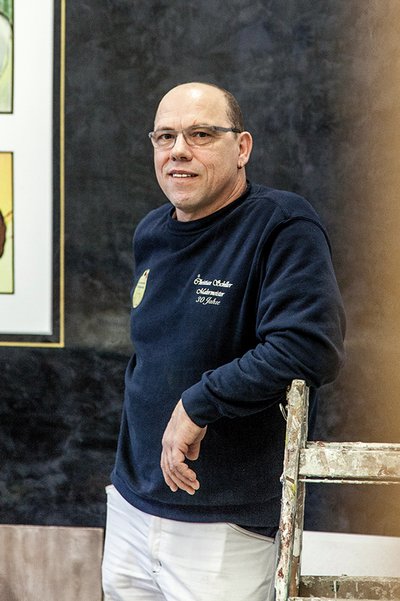
Beers and the code of honor
The master painter and decorator has been freelance for 30 years and he appreciates the fair pricing as a guild member in his position as Head of the Spandau and Charlottenburg district. He complains about dirty business in the industry. Many are not up to his standards and overcharge their customers. "We consider our mission as providing a craft, not ripping off customers."
He raises his voice and starts gesticulating more intensively: "If we deliver good work, we can earn plenty. Nothing more and nothing less." Trainees nod while working on their templates. They not only learn what it is like to meet once a week for a drink or how to work with crackle lacquer, create a marble effect or apply leaf gold.
They also learn about their trade's code of honor. And the code of honor not only specifies that building sites must be left with clean windows, Christian Schiller explains, but also how to handle difficult building owners in a friendly, yet confident way or how to meet extremely creative architects halfway.
Heart, not elbow
The magic within the community is the true secret of a guild according to the bosses of busy companies around Berlin. "In the Middle Ages you shared your expertise, today it's more about putting your elbows out. In this professional group we work against this kind of indifference", Detlef Remmler, 68, says.
These are his final words for now while he is resting his fists on the head of the five meter board. Above him towers a work of art filling an entire wall, showing a guild gathering in the Middle Ages. Depicted characters are discussing issues, laughing and drinking. "That's us", Klaus-Peter Engelhardt shouts from next door, "we just look much better." And there it is again: that faint knocking sound.
Alcohol as an all-rounder
How do you make a door that isn't even made of wood look like old wood? Then Detlef Remmler (below) just opens a beer. The master painters and decorators are fully convinced of beer coatings, as they are able to imitate woodgrain almost perfectly. For this purpose, he gradually adds paint pigments to the beer and applies the mixture. Practical: As long as nothing has been sealed with enamel, you can redo any pattern.
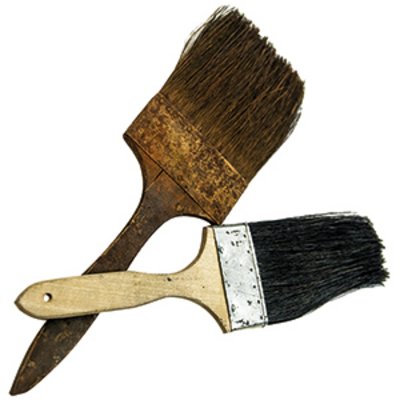
Perfect brush principle
Not everything new is automatically better. The painters of the guilds in the Middle Ages used really simple horse hair brushes to paint. And this has remained the same from the painters of the citadel in Spandau to the present day. The picture shows that the new brush (on the right) is almost completely identical to the old brush: from the shape to the wooden handle. The only difference is the tail color of the horse that provided the hair over one hundred years ago and a little rust. The brush would paint just as well – if it hadn’t been used in the exhibit case.
